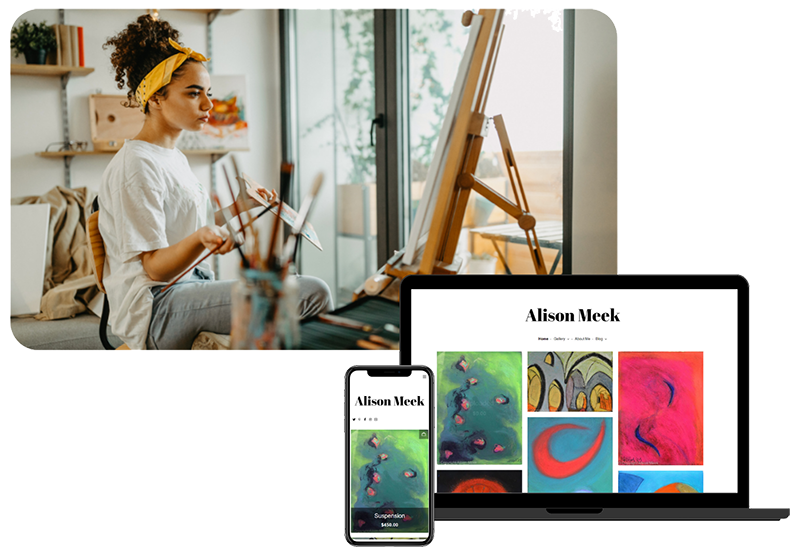Generating multiple income streams is key to building a resilient and successful art business, and producing photographic reproductions of your original artworks can provide an alternative, and potentially passive, source of income. But is making prints of your work always a good idea, and what should you take into account before you commit to offering them?
Could reproducing your artwork in print form undermine the market for your original work?
Some artists hesitate to reproduce their artwork in print form, and some galleries actively advise against it for fear that it could undermine the market for their original works. How concerned you should be about this depends on the price point of original artworks, and the reason for which your clientele buys it: those purchasing decorative artworks to brighten their home might indeed be dissuaded from buying an original work when an attractive and well-framed print could cost them significantly less. On the other hand, collectors who value craftsmanship, the skill involved in the creation of a work of art, and the exclusivity of owning a unique piece may well be prepared to invest more to purchase the original artwork, if they have the budget to do so. For this group of collectors, the narrower the gap in price between an original artwork and a print reproduction of it, the more likely the client is to ‘upgrade’ their purchase to an original work.

Can producing prints damage your relationship with collectors?
Another factor to consider before reproducing your work in print is whether doing so might anger or alienate your clientele. Many buyers are unaware that purchasing an original artwork does not give them copyright over it, which remains with the artist as the creator of the work. In my own experience of working in commercial galleries, I have handled several phone calls from collectors who were horrified to discover that artists were offering reproduction prints of original artworks that they had purchased. Equally, when asked by a client if I could provide a high-resolution photograph of a work that they had bought, as they wanted to have a reproduction printed, I had to delicately explain that I would need to ask the artist’s permission before doing so.
As with so many professional relationships, the best way to handle this issue is through transparency and communication: make it clear on your website (perhaps under a terms of sale section) if you also offer print reproductions of your work, or license them through a third-party company. When selling an artwork, you might also wish to include a note on your invoice informing the purchaser that you retain copyright over the image. If the buyer is unhappy with this, you can decide whether to waive copyright to save the sale, or alternatively negotiate an additional fee to transfer copyright to them.
The advantages of reproducing original artwork as prints

The above concerns aside, reproducing your artworks in print has great commercial potential for artists. Reproduction prints can offer artists a valuable source of income: one of Britain’s most commercially successful artists, Jack Vettriano, for example, was reportedly enjoying a revenue of more than half a million pounds per year for reproductions of his paintings in the early 2000s.
Not all artists, of course, can hope to be as successful or ubiquitous in their print sales, but offering prints at an affordable price point can significantly widen the market for your work, and make it attainable for art enthusiasts who would otherwise be unable to afford an original. Just as fashion houses generate the majority of their profit through sales of affordable luxuries such as perfume and lipstick, rather than via haute couture, you may be surprised by how much you can earn through selling lower-priced prints, rather than original works.
Another advantage of print sales is that they needn’t be fulfilled by artists themselves. Although you can choose to list prints for sale on your own website, and personally process and pack orders, an alternative is to provide high resolution images of your work to companies such as Fine Art America*, who charge a fee for printing orders on demand, and ship prints directly to buyers. Taking this route frees artists of the burden of storing prints, or investing in having stock produced.
(*Editor’s note: ArtWeb does not necessarily endorse Fine Art America; it was included because the author has heard good but anecdotal experience about the service. Artists should always vet services independently to see if they are a good fit for their business needs.)
Another option open to artists is working with an image licensing company such as Bridgeman, who will negotiate licensing fees on artists’ behalf with companies wishing to reproduce their work for commercial purposes, such as reproduction prints, or on book covers. Artists whose prints are stocked by major retailers may also find that this increases demand for their original works, serving as a form of free advertising (at the same time as providing royalties).
Alongside your own website, you might also want to investigate offering print reproductions of your works for sale on other platforms, such as Etsy or Notonthehighstreet. Although these platforms will charge a commission on sales, they also have the potential to bring your work to the attention of a far wider audience, which again might just channel into sales for your original works.






